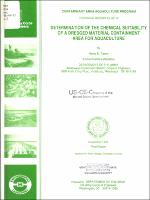Please use this identifier to cite or link to this item:
https://hdl.handle.net/11681/32803| Title: | Determination of the chemical suitability of a dredged material containment area for aquaculture |
| Authors: | Tatem, Henry E. |
| Keywords: | Spoil banks--Environmental aspects Water quality bioassay Dredging spoil--Environmental aspects Marine sediments--Analysis |
| Publisher: | Environmental Laboratory (U.S.) U.S. Army Engineer Waterways Experiment Station. |
| Series/Report no.: | Technical Report (U.S. Army Engineer Waterways Experiment Station.) ; no. Technical Report EL-90-12 |
| Abstract: | This report concerns use of dredged material containment areas (DMCA) for aquaculture, specifically for production of a crop intended for human consumption. New DMCAs used only periodically for dredged material disposal could be managed to produce valuable crops. Previous studies conducted by the Corps of Engineers, including one where shrimp were raised at a DMCA, and others relating to the effects of sediment contaminants on aquatic organisms, are reviewed. The literature indicates that most dredged material is uncontaminated and that many sediment constituents such as metals are relatively unavailable to aquatic animals; DMCAs containing parts-per-million levels of organic contaminants such as pesticides, polychlorinated biphenyls, or petroleum hydrocarbons should not be used for aquaculture without extensive testing. The literature also indicates that aquaculture activities at a DMCA should not increase the bioavailability of sediment contaminants. Chemical analyses of typical reference and contaminated sediments are presented. These data can be used by Corps Districts and aquaculturists for preliminary DMCA sediment evaluations. Evaluation of available physical/chemical data on a DMCA should be a first step in determination of the chemical suitability of a new DMCA for aquaculture. The data should be compared with other local sediment data, data contained in this report, and any other relevant literature data. Lack of data or lack of recent data would strongly indicate the need for sediment testing prior to a District recommending a DMCA for aquaculture. The effects of sediment particle size, organic matter, pH, redox potential, and salinity on contaminants are described. Common sediment contaminants are ranked according to their potential for harm to biota. Mercury (Hg), cadmium (Cd), lead (Pb), and certain chlorinated hydrocarbons were identified as potentially harmful at high concentrations. Chemical and biological testing of sediment from an aquaculture demonstration site at Brownsville, TX, showed that this DMCA was acceptable for aquaculture since the sediment contained a high percentage of sand and low (compared with reference materials) concentrations of contaminants. Organic contaminants were below detection limits. Bioassay results showed the DMCA sediments were not toxic to a test animal (Hysidopsis sp.) or to a proposed aquaculture animal, a penaeid shrimp. Both recent chemical data and bioassay testing of actual DMCA sediments are necessary before a potential DMCA site can be recommended for aquaculture. If either kind of test indicates potential problems, then some additional testing may be necessary. A table of US Food and Drug Administration (USFDA) action levels for contaminants in seafood is included. An aquaculture crop should be monitored during growth to ensure that USFDA action levels or other relevant criteria are not exceeded. Data for the aquaculture crop may be compared with tissue data from local species similar to the aquaculture species. The final section of this report contains discussion of procedures and probable costs involved in determining the chemical suitability of a DMCA for aquaculture. |
| Description: | Technical Report |
| Gov't Doc #: | Technical Report EL-90-12 |
| Rights: | Approved for Public Release; Distribution is Unlimited |
| URI: | https://hdl.handle.net/11681/32803 |
| Appears in Collections: | Technical Report |
Files in This Item:
| File | Description | Size | Format | |
|---|---|---|---|---|
| Technical Report EL-90-12.pdf | 1.66 MB | Adobe PDF |  View/Open |